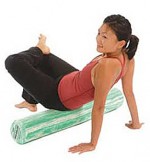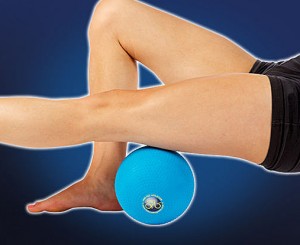An amazingly simple and immediately effective DIY massage relaxes stiffness and removes pain
The foam rolling technique of self- massage is exceptionally beneficial in increasing athletic performance, reducing pain, and helping with injury recovery/prevention —especially for older snow enthusiasts.
The medical term for rolling out is self-myofascial release. “Myo” means muscle, and “fascial” refers to the fascia, a framework of

Credit: Protherapy Supplies
connective tissue that covers the muscles and organs in one continuous structure from head to toe, like a tight sweater over our musculoskeletal system. A restriction in one area can affect fascia and muscles in a completely different part of the body, not unlike pulling fitted polypropylene long johns in one direction and causing the fabric to twist and tighten on another part of the frame.
When fascia is restricted (e.g. injuries, surgeries, poor posture), the muscle beneath may not be able to return to its normal length after contracting, resulting in compromises in range of motion, blood flow, nerve stimulation, and lymphatic drainage. This produces an inflammatory response and nasty little trigger points—or “knots”—that develop in the muscle and/or fascia. Any pressure applied to these trigger points can cause pain.
It’s not uncommon to feel areas of referred pain from another part of the body when compressing a particular trigger point, something to expect with the rolling device.
The good news about trigger points is that when pressure is repeatedly applied against a rolling device in a slow manner with the person taking FULL, DEEP breaths, the pain dissipates quickly, eliminating the myofascial

Credit: Pro-tecathletics
restriction and allowing the muscle to elongate and nearby joints to move fluidly with increased blood flow to the area. The result is enhanced athletic performance.
It’s best to roll out before heading to the mountain. Your muscles will be more supple, and your joints limber and pain-free. For maintenance, roll out daily, either at night or in the morning (or if you can, both.) Start small and progress to longer sessions of myofascial release. While this technique works for all physical activities, skiers should focus on the lower body–hamstring, IT band, Achilles, quads. That said, don’t forget to include the back and any other areas of chronic pain. And for your (HIGHLY recommended) post-skiing stretch, roll out first.
You may have some pain at first, but that should subside after a few times rolling out. In fact, your muscles may soon crave the roller at the end of a long day on the mountain, even more than you crave that après ski beer. And with some dedicated time to rolling out, don’t be surprised if your body feels years younger! It may hurt at first, but the pain should subside after a few times rolling out. In fact, your muscles may soon crave the roller at the end of a long day on the mountain, even more than you crave that après ski beer.
[Ed Note: We have tried myofascial self-massage and can report immediate relief from lower back pain stemming from tight hip flexors and knotted piriformis muscles. Your mileage may vary, but we are very impressed with this technique. As these videos show, you can use a foam roller or a massage ball. We used a hard lacrosse ball to really focus on tight knots. Here are some links for rolling exercises and products:]
Runners World Foam Roller Instruction Series
Finally, some rolling device vendors:












Good article getting the word out on this. I’ve been doing this for years especially with cross country skiing. Trigger point therapy is the term I’ve seen used in addition to Myofascial release. A great website for “toys” is TPtherapy.com. There are massage therapists who specialize in MFR and TP technique. I’d recommend Seeking them out as another way to become acquainted with the possibilities available As they are kind of amazing.
I concur with stiff foam roller(don’t get a soft one) use morning and night if possible. Even before I reached my 60’s my IT band tightness from ultra-running was causing problems in my hips and back. After repeated sessions on the roller I can now move much more comfortably. Best $30 I ever spent, and it travels with me on all my trips! Great article.